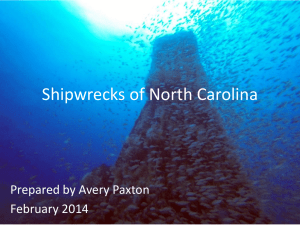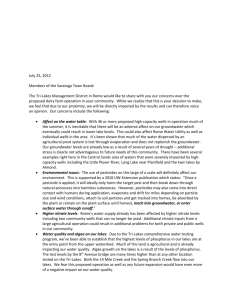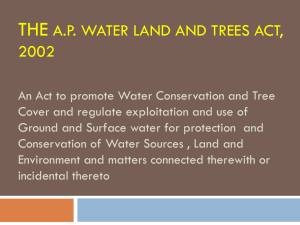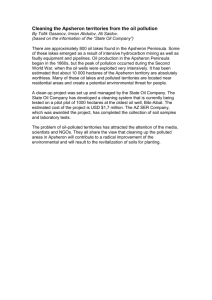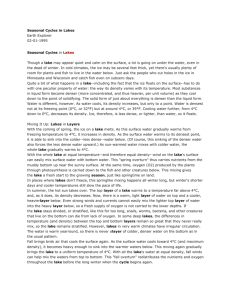Underwater Archaeology Kids` Corner
advertisement
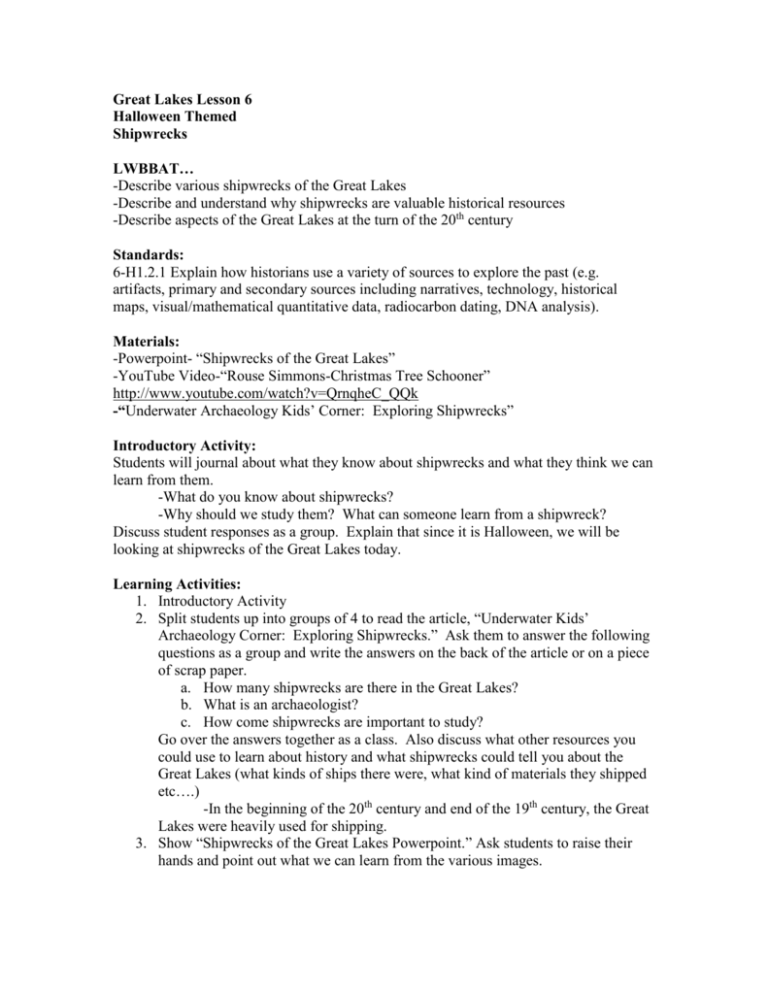
Great Lakes Lesson 6 Halloween Themed Shipwrecks LWBBAT… -Describe various shipwrecks of the Great Lakes -Describe and understand why shipwrecks are valuable historical resources -Describe aspects of the Great Lakes at the turn of the 20th century Standards: 6-H1.2.1 Explain how historians use a variety of sources to explore the past (e.g. artifacts, primary and secondary sources including narratives, technology, historical maps, visual/mathematical quantitative data, radiocarbon dating, DNA analysis). Materials: -Powerpoint- “Shipwrecks of the Great Lakes” -YouTube Video-“Rouse Simmons-Christmas Tree Schooner” http://www.youtube.com/watch?v=QrnqheC_QQk -“Underwater Archaeology Kids’ Corner: Exploring Shipwrecks” Introductory Activity: Students will journal about what they know about shipwrecks and what they think we can learn from them. -What do you know about shipwrecks? -Why should we study them? What can someone learn from a shipwreck? Discuss student responses as a group. Explain that since it is Halloween, we will be looking at shipwrecks of the Great Lakes today. Learning Activities: 1. Introductory Activity 2. Split students up into groups of 4 to read the article, “Underwater Kids’ Archaeology Corner: Exploring Shipwrecks.” Ask them to answer the following questions as a group and write the answers on the back of the article or on a piece of scrap paper. a. How many shipwrecks are there in the Great Lakes? b. What is an archaeologist? c. How come shipwrecks are important to study? Go over the answers together as a class. Also discuss what other resources you could use to learn about history and what shipwrecks could tell you about the Great Lakes (what kinds of ships there were, what kind of materials they shipped etc….) -In the beginning of the 20th century and end of the 19th century, the Great Lakes were heavily used for shipping. 3. Show “Shipwrecks of the Great Lakes Powerpoint.” Ask students to raise their hands and point out what we can learn from the various images. 4. Go over how not only can we learn about history, but we can learn from our mistakes with shipwrecks. Watch Video “Rouse Simmons-Christmas Tree Schooner” http://www.youtube.com/watch?v=QrnqheC_QQk 5. Ask students to complete an end of class journal answering the same questions: What do you know about shipwrecks? Why are they important to learn about? Formative Assessment: -Having the groups answer questions and discuss them aloud about the reading is a way to assess that students comprehended the reading. It also allows the instructor to make sure that students are understanding the main goal of why studying shipwrecks are important and therefore meeting one of the objectives. -Having students discuss the slides of the “Shipwrecks of the Great Lakes” powerpoint will allow the instructor to see how well students are applying the concept of using shipwrecks to study the past. It is also a way to assess students’ historical knowledge of the Great Lakes ( -The final journal at the end of class will be a way too see how students’ knowledge and understanding of the topic has improved during the class. Notes: Lesson Idea taken from: http://www.lessonplanet.com/search?keywords=great+lakes+shipwrecks&media=lesson According to shipwreck historian Frederick Stonehouse, the southern shore of Lake Superior between Grand Marais, Michigan, and Whitefish Point is known as the "Graveyard of the Great Lakes" and more ships have been lost around the Whitefish Point area than any other part of Lake Superior.[25] These shipwrecks are now protected by the Whitefish Point Underwater Preserve. The SS Edmund Fitzgerald was the last major shipwreck on Lake Superior, sinking 17 miles (27 km) from Whitefish Point on November 10, 1975. According to legend, "Lake Superior seldom gives up her dead".[26] This is because of the unusually low temperature of the water, estimated at under 36 °F (2 °C) on average around 1970.[17] Normally bacteria feeding on a sunken decaying body will generate gas inside the body, causing it to float to the surface after a few days. The water in Lake Superior is cold enough year-round to inhibit bacterial growth, and bodies tend to sink and never surface.[27] This is alluded to in Gordon Lightfoot's ballad, "The Wreck of the Edmund Fitzgerald". The Edmund Fitzgerald's 29 crew members all perished. Edmund Fitzgerald adventurer Joe MacInnis reported that in July 1994, explorer Frederick Shannon's Expedition 94 to the Fitzgerald discovered and filmed a man's body near the port side of her pilothouse, not far from the open door, "fully clothed, wearing an orange life jacket, and lying face down in the sediment."[28] No crew members were ever recovered. The Fitzgerald was swallowed up so intensely by Lake Superior that the 729-foot (222 m) ship split in half. Her two pieces are sitting approximately 170 feet (52 m) apart in a depth of 550 feet (170 m). http://en.wikipedia.org/wiki/Lake_Superior Many theories, books, studies and expeditions have examined the cause of the sinking. Fitzgerald may have fallen victim to the high waves of the storm, suffered structural failure, been swamped with water entering through her cargo hatches or deck, experienced topside damage or shoaled in a shallow part of Lake Superior. Investigations into the sinking led to changes in Great Lakes shipping regulations and practices that included mandatory survival suits, depth finders, positioning systems, increased freeboard, and more frequent inspection of vessels http://en.wikipedia.org/wiki/SS_Edmund_Fitzgerald Underwater Archaeology Kids' Corner Exploring Shipwrecks The Steamer Bluff City, which burned in 1897. WHi(X3)27162, WHS Archives The Great Lakes can be very dangerous for the men and women that work upon these waters. Did you know that there are over 10,000 shipwrecks at the bottom of the Great Lakes, and each one is a museum waiting to be explored? What do these shipwrecks tell us about the past? How do underwater archaeologists investigate these sites (places)? To find the answers to these questions, put on your mask and snorkel (underwater breathing gear), and let's dive into more of Wisconsin's maritime history. DID YOU KNOW? Twenty-two percent of Wisconsin is under water. Beneath the lakes and rivers lie not just shipwrecks, but thousands of other archaeological sites (places). Archaeologists have found the remains of fur trading posts, lumber mills, quarries, and other structures. They have also found objects such as ice harvesting tools and early Native American fishing gear. Underwater archaeologists study these artifacts to learn more about our past. Wisconsin has a long and interesting maritime history. From 2,000 year old canoes to giant bulk freighters, many types of "watercraft" have sailed upon Wisconsin waters. Have you ever wondered how we know all this information about the past? Much of it comes from historical documents (documents, written records), such as journals, newspapers, or letters written by people who actually lived at the time. But not enough written documents exist to tell us everything that we want to know about the past. Shipwrecks are a great source for learning more about our maritime past, and underwater archaeologists find clues about our history in shipwrecks. The schooner crew's clothing and other personal items are among the things that can be found on a shipwreck. Institute for Great Lakes Research at Bowling Green University Shipwrecks are time capsules. Their remains tell us what people did at a very specific time. If a ship sank in 1859, everything on board came from 1859 or earlier. The clothing, eating utensils, tools, navigational instruments, cargo, and personal items found on a shipwreck, and the ship itself, tell us the story of how people lived and worked at a certain time in the past. Underwater archaeologists can also interpret (in tur preht, explain) the sunken artifacts and tell us how the ships were built and why they sank. Archaeologists record information about one of Wisconsin's seven hundred shipwrecks. Underwater Archaeology, WHS Once on the bottom of a lake or river, a shipwreck often remains protected by the water that hides it. Wisconsin's cold, fresh water preserves materials much better than if they were in salty ocean water. This explains why Great Lakes shipwrecks are considered some of the best in the world. A canoe in Kenosha survived for nearly 2,000 years before it was discovered! In some special cases, underwater archaeologists can find nearly everything that was aboard a ship when it sailed. But before exploring how archaeologists study shipwrecks, you'll learn some of the reasons why ships sank. http://www.wisconsinhistory.org/shipwrecks/kids/exploring.asp
